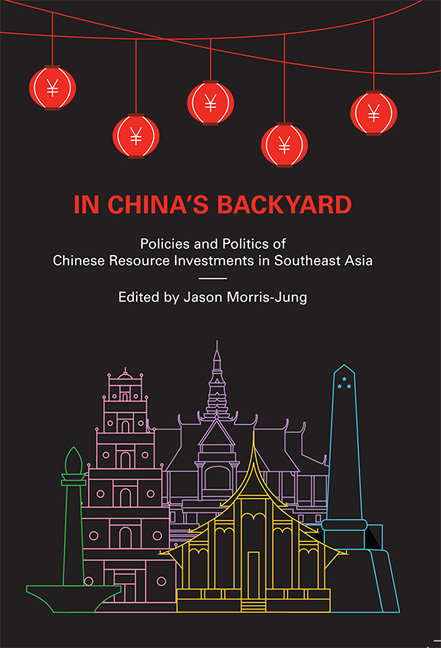Book contents
- Frontmatter
- Contents
- Foreword
- Acknowledgements
- About the Contributors
- 1 Introduction
- 2 Mixed Motivations, Mixed Blessings: Strategies and Motivations for Chinese Energy and Mineral Investments in Southeast Asia
- 3 Mineral Resources in China's “Periphery” Diplomacy
- 4 Energy Entanglement: New Directions for the China–Indonesia Coal Relationship
- 5 Indonesia–China Energy and Mineral Ties: The Rise and Fall of Resource Nationalism?
- 6 The Direction, Patterns, and Practices of Chinese Investments in Philippine Mining
- 7 Development Cooperation with Chinese Characteristics: Opium Replacement and Chinese Rubber Investments in Northern Laos
- 8 The High Cost of Effective Sovereignty: Chinese Resource Access in Cambodia
- 9 Complex Contestation of Chinese Energy and Resource Investments in Myanmar
- 10 Anti-Chinese Protest in Vietnam: Complex Conjunctures of Resource Governance, Geopolitics and State–Society Deadlock
- 11 Complexities of Chinese Involvement in Mining in the Philippines
- 12 Conclusion
- Bibliography
- Index
9 - Complex Contestation of Chinese Energy and Resource Investments in Myanmar
Published online by Cambridge University Press: 04 July 2018
- Frontmatter
- Contents
- Foreword
- Acknowledgements
- About the Contributors
- 1 Introduction
- 2 Mixed Motivations, Mixed Blessings: Strategies and Motivations for Chinese Energy and Mineral Investments in Southeast Asia
- 3 Mineral Resources in China's “Periphery” Diplomacy
- 4 Energy Entanglement: New Directions for the China–Indonesia Coal Relationship
- 5 Indonesia–China Energy and Mineral Ties: The Rise and Fall of Resource Nationalism?
- 6 The Direction, Patterns, and Practices of Chinese Investments in Philippine Mining
- 7 Development Cooperation with Chinese Characteristics: Opium Replacement and Chinese Rubber Investments in Northern Laos
- 8 The High Cost of Effective Sovereignty: Chinese Resource Access in Cambodia
- 9 Complex Contestation of Chinese Energy and Resource Investments in Myanmar
- 10 Anti-Chinese Protest in Vietnam: Complex Conjunctures of Resource Governance, Geopolitics and State–Society Deadlock
- 11 Complexities of Chinese Involvement in Mining in the Philippines
- 12 Conclusion
- Bibliography
- Index
Summary
Many Chinese large-scale investments, particularly those in the energy andnatural resource sectors, have encountered nationwide protest in Myanmar.These protests have radically called for project terminations, which partlyresulted in President Thein Sein's decision to suspend construction on theChinese-backed mutli-billion dollar investment in the Myitsone dam in2011. This incident has been widely regarded as a turning point in what hadhitherto been seen as close relations between China and Myanmar. Bringingthe research gaze down to the local level, this chapter examines the contextand conditions of interactions between key Chinese actors and Myanmarcivil society. It argues that a restrictive legal and political context,organizational limitations, and dismissive attitudes towards civil societyhave engendered mutual suspicion and mistrust between local Myanmaractivists and Chinese companies. This, in turn, has hindered the developmentof more formal or regular communication channels between actors anddisadvantaged Chinese efforts to build reputation and trust within the widerMyanmar public.
Introduction
In recent years, under the democratizing environment in Myanmar, civil society has mounted forceful campaigns against irresponsible foreign investment practices, which have included Chinese, Thai, Indian and South Korean companies. However, Chinese investments account for about a third of Myanmar's total cumulative foreign investment of US$62.6 billion, as of 2017. Most of the protest has been in the energy and natural resource industries, whose propensities for extensive socioenvironmental impacts have encountered the most resistance. Much of it has been labelled and, indeed, presented itself as “anti-Chinese”. As this chapter demonstrates, however, the causes of protest in Myanmar are multiple and complex.
Protests have played a critical role in compelling Chinese interlocutors — including state-companies, the embassy in Yangon, the Chinese Ministry of Commerce, and Chinese scholars — to confront the demands of Myanmar civil society. This chapter will first provide a brief overview of Chinese investments in Myanmar, followed by an examination of anti-Chinese sentiments as they have emerged through complex historical relations, local politics and Chinese investment practices. It analyses how Chinese interlocutors, whose conventional diplomatic and business approach is to deal predominantly with host governments, perceive and interact with local civil society actors in Myanmar, especially as their protests make these interactions inevitable.
- Type
- Chapter
- Information
- In China's BackyardPolicies and Politics of Chinese Resource Investments in Southeast Asia, pp. 204 - 228Publisher: ISEAS–Yusof Ishak InstitutePrint publication year: 2017

